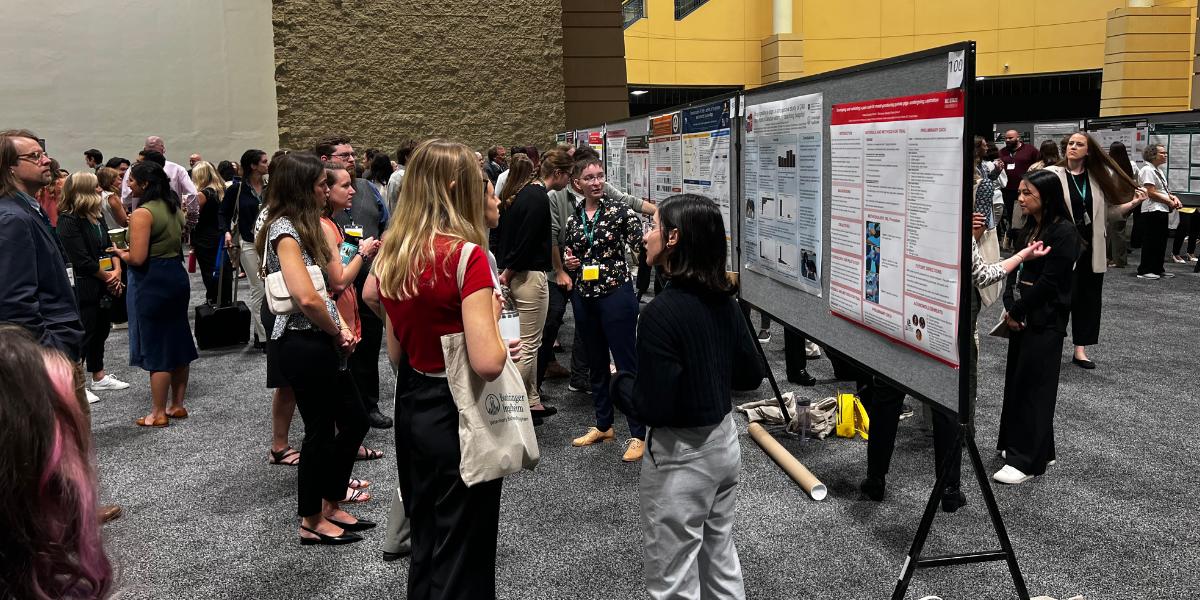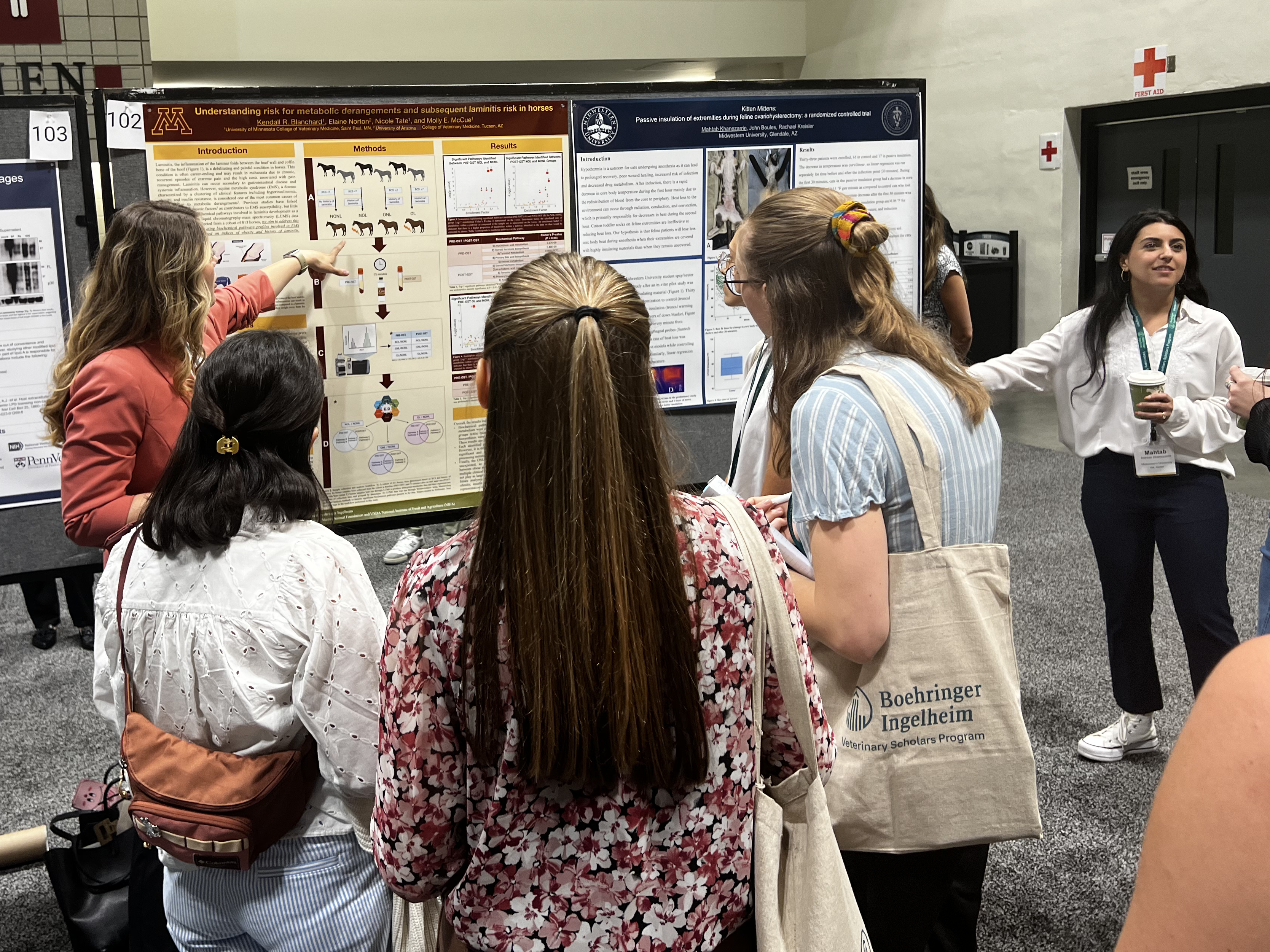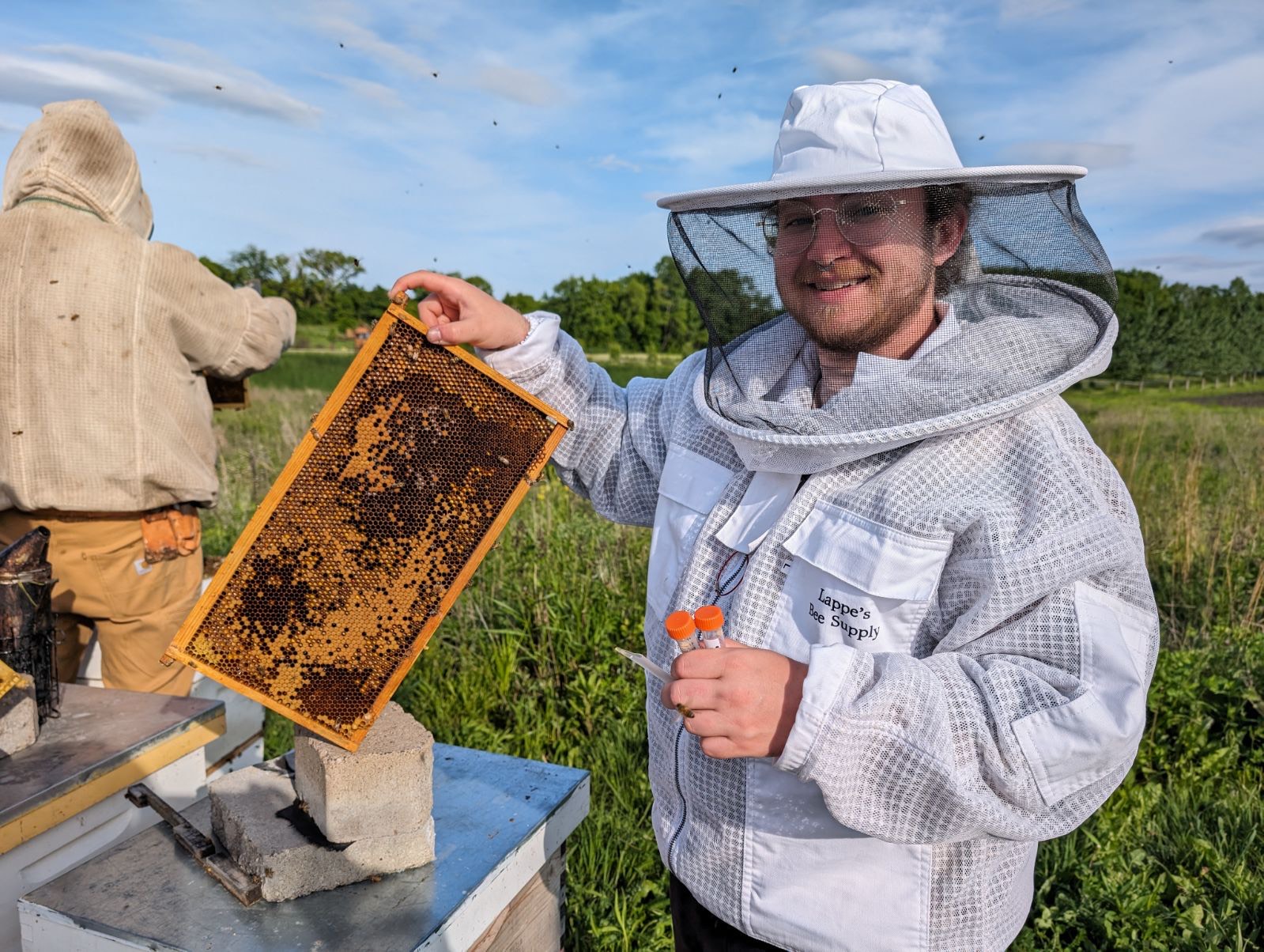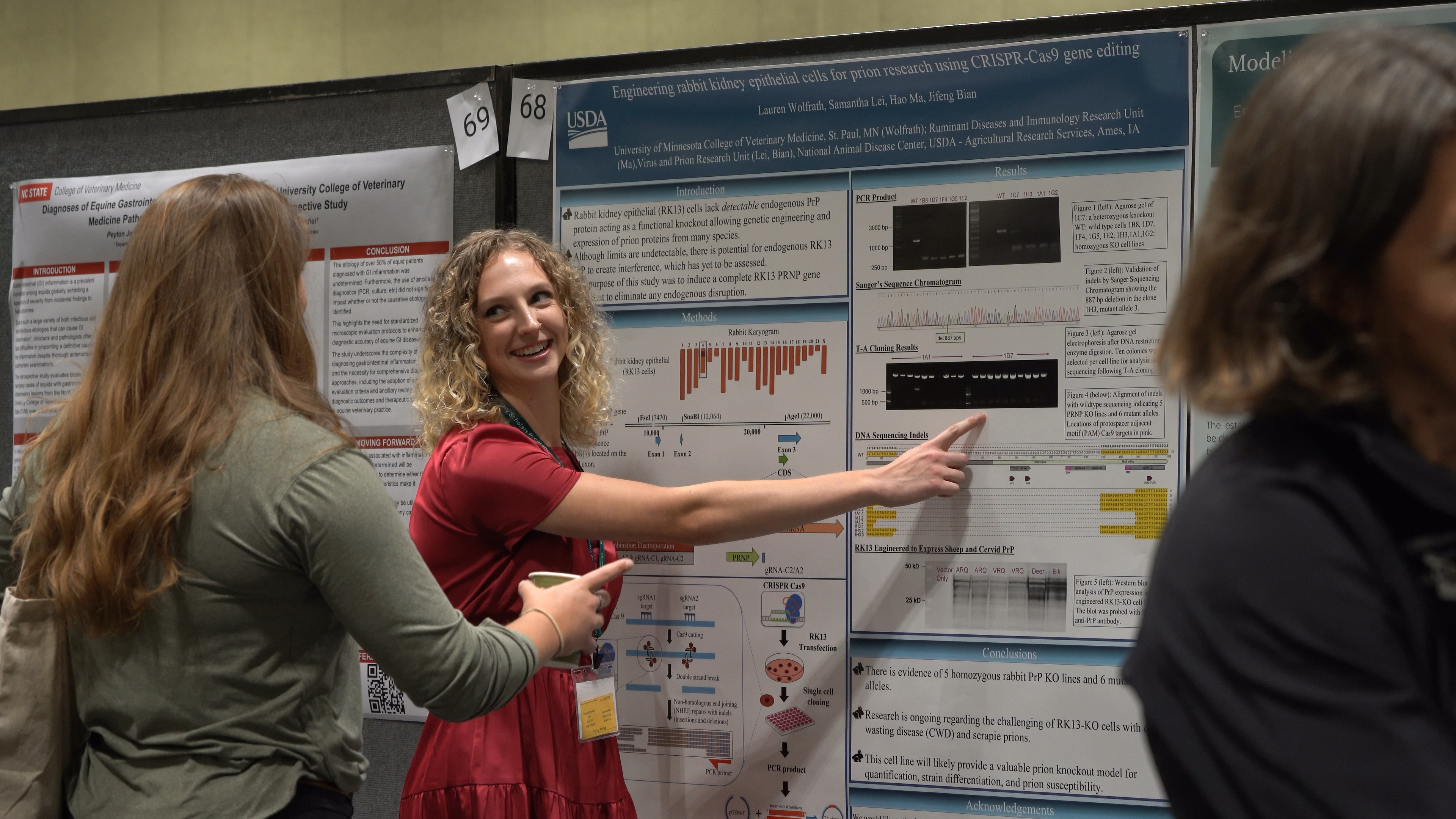Discovering the future
From lab to field to academic conference, participants in CVM’s 2024 Veterinary Summer Scholars program explore the world of research.

From lab to field to academic conference, participants in CVM’s 2024 Veterinary Summer Scholars program explore the world of research.
Participants of the 2024 Veterinary Scholars summer research program present their research posters at the Veterinary Scholars Symposium, held August 8–10 this year in Saint Paul, Minn.
The 2024 Veterinary Summer Scholars research program wrapped up with the Veterinary Scholars Symposium, held August 8–10 in Saint Paul, Minn. The program offers incoming, first-year, and second-year veterinary students the opportunity to participate in research projects related to biomedical, agricultural, and ecosystem health initiatives.
Through this experiential learning, students gain an appreciation of biomedical and veterinary research careers and see firsthand how research contributes to advances in health care, one health, and veterinary practice. The University of Minnesota has a long history with the now 35-year-old Veterinary Scholars program, which has grown to include every U.S. veterinary college along with numerous international schools.
Students compete for placement on projects that have been submitted by CVM research faculty. Those who are selected spend 10–12 weeks conducting research and attending field trips, seminars, and trainings designed to develop scientific, critical thinking, and communication skills and explore research-related career paths.

Boehringer Ingelheim funds a number of positions every summer, matched and supplemented by other funding sources including the National Institutes of Health (NIH), the Morris Animal Foundation, and the College and its departments, along with individual research labs. This year’s cohort of 23 scholars included the addition of six scholars funded by a grant from the NIH, led by Dr. Ned Patterson, with a focus on comparative medicine.
“This year we expanded the types of projects students worked on, as well as the training opportunities for students,” says Tom Molitor, director of the U of M Veterinary Summer Scholars program in 2024.
The Symposium, hosted by the American Association of Veterinary Medical Colleges, gave participants the opportunity to share their projects and learn from top researchers in their fields. Their projects reflected the breadth and diversity of work conducted in labs across the College—from the epidemiology of emerging food animal diseases, to immunotherapies for canine and human cancers, to the genetics of disease risk in horses, and much more.
Destiny Smith, a second-year veterinary student, says “the stars aligned” for her participation. Her primary interest is cows, and she had approached Dr. Sandra Godden to see if she could join any of her projects. Godden told her she was interested in doing a study with newborn calves—but there were logistical challenges because the farm was about 1.5 hours from campus, in Hutchinson, Minn. It just so happened that Smith was living in Hutchinson, so it turned out to be a perfect fit.

Smith spent her summer days on the farm, where she took blood samples to test the impact of a second feeding of colostrum, the nutrient-rich milk that is produced immediately after a baby is born, on the health and well-being of calves. Findings from the study could help inform best practices on dairy farms
“There was definitely a learning curve because I’ve never done research with live animals,” says Smith, who had done some lab-based research for her microbiology capstone project as an undergraduate student. “The biggest challenge was seeing how many calves I could work with in a day—there was a lot to track, and each calf needed follow-up the next day, so there were a lot of moving parts.”
She loved the hands-on nature of the experience and was grateful for the connections she made. As for the Symposium, she says, it was “really cool to see how many amazing things people are researching, and how passionate they are about it—we need that in this world!”
Smith plans to pursue a career as a rural clinician working with large animals, but she says that she’d love to support research in the future by gathering data and doing other work in the field.
Mo Usavage, also a second-year student, was interested in the program because they “wanted to understand how the sausage gets made”—how research happens from the ground up with idea generation and grant writing. With their mentor Dr. Melinda Wilkins, Usavage studied foulbrood, a bacterial disease affecting honey bees, to learn about its potential impact in North America by conducting an extensive review of the existing research.
“When we started, we didn’t really know where it would take us, and every time we were able to answer a question, it inspired us to ask six more. It was so fun—and now we have a concrete path forward for future research,” Usavage says.

What Usavage’s review found was that “we don’t really know anything about how the disease is operating in the U.S., as it turns out, not even how prevalent it is. We want to know the prevalence in Minnesota, what strains we have here, if any of them show signs of [drug resistance]—there’s a lot to learn.”
In addition to conducting the review, Usavage was able to go into the field to learn about bee handling and gather some samples that can be used to start answering some of these questions. The experience “solidified the direction I want to go,” they say. “If I can take the things I love about research, like data management and analysis, and bring them into the field, that would be great—or bring what I know about research into an evidence-based medicine approach in a clinical role.”
Lauren Wolfrath, another second-year student, came into the program having already developed a passion for research, and wanting to understand what it might mean to pursue research as a career.
Wolfrath was able to take advantage of a United States Department of Agriculture (USDA) program that pairs select Veterinary Scholars with researchers working at USDA sites on livestock infectious diseases. She spent the summer at the National Animal Disease Center in Ames, Iowa, in its Virus and Prion Research Unit under the direction of Dr. Jifeng Bian.
“I gained skills with field work and animal sampling as well as benchtop and technical skills,” Wolfrath described. “I was able to take my project from the very beginning, performing experiments, conceptualizing protocols, and ensuring proper control samples to the very end by quantifying my data, analyzing it, and creating graphical representations that could easily express these concepts.”

Her project involved using cutting-edge genetics techniques to create a cell line—a population of cells with specific characteristics and functions that can be maintained and reproduced for future research. The cell line was designed specifically for research into prion diseases, which are a type of neurodegenerative diseases that affect both humans and animals.
“It was an amazing community and team at the National Animal Disease Center,” Wolfrath says Additionally, she notes “the conference was a great chance to reconnect with my peers after being away for the summer. It was so great to engage with other students and faculty about my project, which was very important to me.”
Wolfrath hopes to enroll in a PhD program after she completes her DVM. She’d like to continue researching prion diseases, including Creutzfeldt Jakob's disease, bovine spongiform encephalopathy, scrapie, and chronic wasting disease.
“There is so much headway we need to make in prion research, as we currently lack proper diagnostics and treatments for these diseases that are always fatal,” she says. “I am hoping I can contribute to this effort in the future.”
Many program participants go on to pursue advanced training in addition to their veterinary degree, including graduate degrees such as PhDs and Masters of Public Health. Such advanced degrees lead to research careers that promote both animal and human health.
“What an impressive group of veterinary students and projects we had this year,” Molitor says. “We thank the faculty mentors and their research groups for providing guidance to these outstanding students.”
If you would like to learn how to support a 2025 Summer Scholar, please contact CVM Lead Development Officer Reede Webster at 612-209-8267 or webst033@umn.edu. Your financial support helps our students experience the rewarding world of veterinary research.